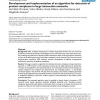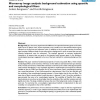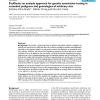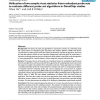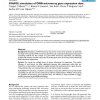BMCBI
2006
13 years 11 months ago
2006
Background: When accurate models for the divergent evolution of protein sequences are integrated with complementary biological information, such as folded protein structures, anal...
BMCBI
2006
13 years 11 months ago
2006
Background: Detection of periodically expressed genes from microarray data without use of known periodic and non-periodic training examples is an important problem, e.g. for ident...
BMCBI
2006
13 years 11 months ago
2006
Background: After complete sequencing of a number of genomes the focus has now turned to proteomics. Advanced proteomics technologies such as two-hybrid assay, mass spectrometry e...
BMCBI
2006
13 years 11 months ago
2006
Background: In a microarray experiment the difference in expression between genes on the same slide is up to 103 fold or more. At low expression, even a small error in the estimat...
BMCBI
2006
13 years 11 months ago
2006
Background: We present a general approach to perform association analyses in pedigrees of arbitrary size and structure, which also allows for a mixture of pedigree members and ind...
BMCBI
2006
13 years 11 months ago
2006
Background: The choice of probe set algorithms for expression summary in a GeneChip study has a great impact on subsequent gene expression data analysis. Spiked-in cRNAs with know...
BMCBI
2006
13 years 11 months ago
2006
Background: Low-level processing and normalization of microarray data are most important steps in microarray analysis, which have profound impact on downstream analysis. Multiple ...
BMCBI
2006
13 years 11 months ago
2006
Background: Simulation of DNA-microarray data serves at least three purposes: (i) optimizing the design of an intended DNA microarray experiment, (ii) comparing existing pre-proce...
BMCBI
2006
13 years 11 months ago
2006
Background: Character mapping on phylogenies has played an important, if not critical role, in our understanding of molecular, morphological, and behavioral evolution. Until very ...
BMCBI
2006
13 years 11 months ago
2006
Background: The increasing availability of time-series expression data opens up new possibilities to study functional linkages of genes. Present methods used to infer functional l...

